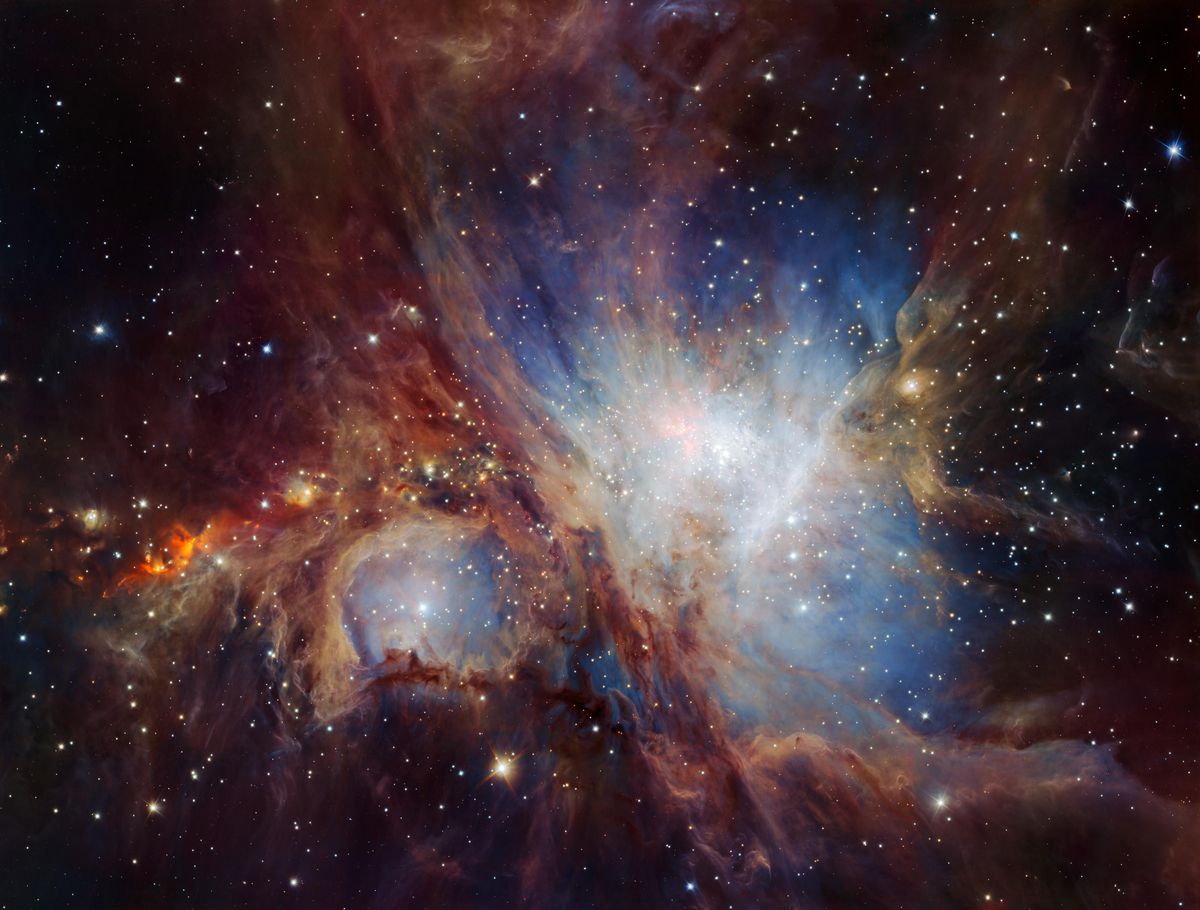
This spectacular image of the Orion Nebula, complete with its incredibly rich star-formation region, … [+]
ESO/H. Drass et al.
Shining brilliantly in January’s skies is the Great Orion Nebula.

By 10 PM every night in January from the Northern Hemisphere, Orion will be high and brilliant in … [+]
Stellarium
Located just over 1,000 light-years away, it’s the closest major star-forming region to Earth.

The great Orion Nebula is a fantastic example of an emission nebula, as evidenced by its red hues … [+]
NASA, ESA, M. Robberto (Space Telescope Science Institute/ESA) and the Hubble Space Telescope Orion Treasury Project Team
It includes the Northern Hemisphere’s most prominent, reliable winter sights.

This wide-field view of the constellation of Orion shows the belt (middle), the bright orange … [+]
Skatebiker at English Wikipedia
The main nebula, Messier 42, is visible to the naked eye.

A more magnified, deeper view of the Orion Nebula showcases a number of bright stars individually … [+]
Bryan Goff / Wikimedia Commons
Through a telescope, its features are spectacular.

Star-forming regions, like the one housing the Trapezium Cluster inside the Orion Nebula, in visible … [+]
NASA; K.L. Luhman (Harvard-Smithsonian Center for Astrophysics, Cambridge, Mass.); and G. Schneider, E. Young, G. Rieke, A. Cotera, H. Chen, M. Rieke, R. Thompson (Steward Observatory, University of Arizona, Tucson, Ariz.); NASA, C.R. O’Dell and S.K. Wong (Rice University)
The bright Trapezium star cluster lights up the nebula’s center.

There are many brilliant blue stars present in the Orion Nebula, far outnumbered by the white, … [+]
Stephan Hamel
The oldest of these stars formed just 12 million years ago.

This image shows the Orion Molecular Clouds, the target of the VANDAM survey. Yellow dots are the … [+]
ALMA (ESO/NAOJ/NRAO), J. Tobin; NRAO/AUI/NSF, S. Dagnello; Herschel/ESA
The Orion Nebula is laden with protoplanetary disks: future solar systems.
Visible light views showcase stars, emission, and reflection nebulae.
Infrared views see through the dust, revealing ongoing regions of star formation.

Although its neighbor, Messier 42, gets all the attention, Messier 43 lies just across a dust lane … [+]
Yuri Beletsky (Carnegie Las Campanas Obs.), Igor Chilingarian (Harvard-Smithsonian CfA)
Next door is Messier 43, separated from the main nebula by a single large dust lane.

The Orion Nebula, seen again below the three belt stars, is just a tiny portion of the great … [+]
Rogelio Bernal Andreo
All this is included within the greater Orion Molecular Cloud Complex.

This enormous molecular cloud complex has many different components (labeled), which was constructed … [+]
IRIS + Dame et al. 2001/ Meli thev of Wikimedia Commons
Approximately 400 light-years across, it’s rich in notable astronomical objects.

In visible light, the Horsehead nebula appears as a dark silhouette against a hydrogen-rich, light … [+]
T.A.Rector (NOAO/AURA/NSF) and Hubble Heritage Team (STScI/AURA/NASA)
The dark Horsehead Nebula silhouettes a background emission nebula.

The Flame Nebula, illuminated by a nearby blue star (the left-most star of Orion’s belt), is lit up … [+]
ESO/J. Emerson/VISTA. Acknowledgment: Cambridge Astronomical Survey Unit
Nearby, the Flame Nebula is illuminated by a nearby blue star.

Ultra-hot, young stars can sometimes form jets, like this Herbig-Haro object in the Orion Nebula, … [+]
ESA / Hubble & NASA, D. Padgett (GSFC), T. Megeath (University of Toledo), and B. Reipurth (University of Hawaii)
Young stars exhibiting shocks — Herbig-Haro stars — are common here.

Although Messier 78 is located quite far away from the Orion Nebula and the other Messier objects … [+]
ESO/Igor Chekalin
Brilliant blue reflection nebulae, like Messier 78, are also ubiquitous.

This brilliant composition by astrophotographer Rob Gendler shows a portion of the Orion Complex, … [+]
Robert Gendler/Nighthawk Observatory (www.robgendlerastropics.com)
Spanning over 100 square degrees, the Orion Complex is the largest single structure visible from Earth.

The enormous amount of red shown here indicates the emission features of ionized hydrogen, and yet … [+]
Rogelio Bernal Andreo, CC BY-NC-ND 3.0; Annotations by E. Siegel
Mostly Mute Monday tells an astronomical story in images, visuals, and no more than 200 words. Talk less; smile more.
This article is auto-generated by Algorithm Source: www.forbes.com


